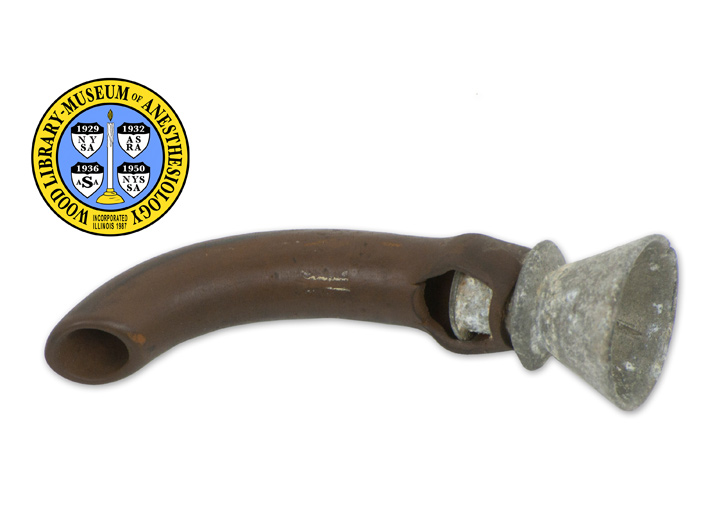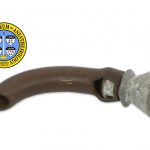Hewitt Airway
Dr. Frederic W. Hewitt (1857-1916) introduced the first modern airway in 1908. The mouth and throat easily close during anesthesia because of the relaxation of muscles that normally hold the back of the mouth and throat open, and the jaw forward. Oral-airways are inserted over the tongue to create an air passage from the mouth to the far back of the throat. Numerous modifications and innovations have occurred since 1908 to make modern oral-airways much more effective. These developments have included different shapes, sizes, and materials, such as plastic.
Dr. Hewitt was a physician who specialized in anesthesia, an uncommon choice during his time. He was also an inventor of numerous anesthesia-related devices, a busy researcher, a writer of scholarly articles and popular books on the administration of anesthesia, and an early advocate for minimum education and training requirements for anesthesia providers. He was so highly respected that he was appointed the official Anesthetist to King Edward VII, and later to King George V.
Catalog Record: Hewitt Airway
Access Key: aikc
Accession No.: 1939-10-11-1 C
Title: [ Hewitt airway / designed by Frederic W. Hewitt.]
Author: Hewitt, Frederic William, Sir, 1857-1916.
Title variation: Alt Title
Title: Hewitt airway with rubber tube.
Title variation: Alt Title
Title: Hewitt’s air-way.
Title variation: Alt Title
Title: “Ring” airway.
Publisher: [S.l. : s.n., 1912.]
Physical Description: 1 oropharyngeal airway : rubber, die cast zinc ; 10.5 x 5.5 x 3.2 dia. cm.
Subject: Airways.
Subject: Airway Management Equipment.
Subject: Oropharyngeal Airway Devices.
Subject: Airway Obstruction – prevention & control.
Note Type: General
Notes: Title based on the WLM name for the object.
Note Type: Citation
Notes: Edwards G. Frederic William Hewitt (1857-1916): first Frederic Hewitt Lecture
delivered at the Royal College of Surgeons of England on 1st November, 1950.
Ann R Coll Surg Engl. 1951;8(3):233–245.
Note Type: Citation
Notes: Haridas RP. The Hewitt airway – the first known artificial oral ‘air-way’ 101
years since its description. Anaesthesia. 2009;64(4):435-438.
Note Type: Citation
Notes: Hewitt FW. An artificial “air-way” for use during anaesthetisation. Lancet.
1908;171(4407):490-491.
Note Type: Physical Description
Notes: One airway with a metal, biconical-like ring and a collar, with a slightly
curved hard rubber tube; The ‘biconical’ ring might also be described as two
truncated cones that come together at their narrow ends to form a flare at
each end and a groove in the center; A short metal collar protrudes from the
proximal end of the ring into the mouth; A rubber tube fits snugly over the
collar; The pharyngeal end of the rubber tube is cut obliquely.
Note Type: Reproduction
Notes: Photographed by Mr. William Lyle, 7/14/2010.
Note Type: Acquisition
Notes: Donated to the WLM by the Australian Society of Anaesthetists in 1939.
Note Type: Historical
Notes: Hewitt was the first to design an oropharyngeal tube to maintain patency of
the airway during anesthesia. The ‘oral-airway’ he introduced in a 1908
Lancet article was straight, but later designs incorporated a curve. His oral
airways were manufactured by C. Barth and Co. of London.
Note Type: Historical
Notes: Dr. Hewitt was a physician who specialized in anesthesia, an uncommon choice
during his time. He was also an inventor of numerous anesthesia-related
devices, a busy researcher, a writer of scholarly articles and popular books
on the administration of anesthesia, and an early advocate for minimum
education and training requirements for anesthesia providers. He was so
highly respected that he was appointed the official Anesthetist to King
Edward VII, and later to King George V (Edwards, 1950).
Note Type: Publication
Notes: McIntyre, JWR. History of anaesthesia: oropharyngeal and nasopharyngeal
airways: I (1880-1995). Can J Anaesth. 1996;43(6):629-635.




